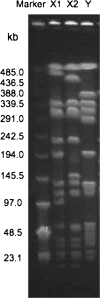Methicillin-resistant Staphylococcus pseudintermedius in a veterinary teaching hospital
- PMID: 17267624
- PMCID: PMC1865850
- DOI: 10.1128/JCM.02193-06
Methicillin-resistant Staphylococcus pseudintermedius in a veterinary teaching hospital
Abstract
We surveyed methicillin-resistant coagulase-positive staphylococcus (MRCPS) strains from 57 (26 inpatient and 31 outpatient) dogs and 20 veterinary staff in a veterinary teaching hospital. From the staff, three MRCPS strains were isolated, and two were methicillin-resistant Staphylococcus aureus (MRSA). In contrast, 18 MRCPS strains were detected in both inpatient (12 of 26 [46.2%]) and outpatient (6 of 31 [19.4%]) dogs. Among them, only one strain was MRSA. Using direct sequencing of sodA and hsp60 genes, the 18 MRCPS strains other than MRSA from a staff and 17 dogs, were finally identified as Staphylococcus pseudintermedius, a novel species of Staphylococcus from a cat. All of the methicillin-resistant S. pseudintermedius (MRSP) strains were multidrug resistant to erythromycin, clindamycin, trimethoprim-sulfamethoxazole, and levofloxacin. Most of the MRSP strains showed high-level resistance to oxacillin (>/=128 mug/ml, 15 of 18 [83.3%]), and 10 of 15 (66.7%) high-level oxacillin-resistant MRSP strains carried type III SCCmec. DNA fingerprinting of MRSP strains by pulsed-field gel electrophoresis yielded eight clusters: clone A with four subtypes, clone B with four subtypes, clone C with three subtypes, and five other different single clones. MRSP strains from the staff and some inpatient and outpatient dogs shared three major clones (clones A, B, and C), but the strains of the other five different clusters were distributed independently among inpatient or outpatient dogs. This genetic diversity suggested that the MRSP strains were not only acquired in this veterinary teaching hospital but also acquired in primary veterinary clinics in the community. To our knowledge, this is the first report of MRSP in dogs and humans in a veterinary institution.
Figures




Similar articles
-
New categories designated as healthcare-associated and community-associated methicillin-resistant Staphylococcus pseudintermedius in dogs.Microbiol Immunol. 2016 Aug;60(8):540-51. doi: 10.1111/1348-0421.12401. Microbiol Immunol. 2016. PMID: 27417508
-
Methicillin-resistant staphylococci amongst veterinary personnel, personnel-owned pets, patients and the hospital environment of two small animal veterinary hospitals.Vet Microbiol. 2018 Sep;223:79-85. doi: 10.1016/j.vetmic.2018.07.021. Epub 2018 Jul 25. Vet Microbiol. 2018. PMID: 30173756
-
Occurrence and molecular characteristics of methicillin-resistant Staphylococcus aureus and methicillin-resistant Staphylococcus pseudintermedius in an academic veterinary hospital.Appl Environ Microbiol. 2010 Aug;76(15):5165-74. doi: 10.1128/AEM.02780-09. Epub 2010 Jun 11. Appl Environ Microbiol. 2010. PMID: 20543040 Free PMC article.
-
Review on methicillin-resistant Staphylococcus pseudintermedius.J Antimicrob Chemother. 2011 Dec;66(12):2705-14. doi: 10.1093/jac/dkr367. Epub 2011 Sep 19. J Antimicrob Chemother. 2011. PMID: 21930571 Review.
-
Multidrug-resistant opportunistic pathogens challenging veterinary infection control.Vet Microbiol. 2017 Feb;200:71-78. doi: 10.1016/j.vetmic.2016.05.017. Epub 2016 May 27. Vet Microbiol. 2017. PMID: 27291944 Review.
Cited by
-
Detection and sequence analysis of accessory gene regulator genes of Staphylococcus pseudintermedius isolates.Vet World. 2015 Jul;8(7):902-7. doi: 10.14202/vetworld.2015.902-907. Epub 2015 Jul 23. Vet World. 2015. PMID: 27047173 Free PMC article.
-
Prevalence of mecA, mecC and Panton-Valentine-Leukocidin Genes in Clinical Isolates of Coagulase Positive Staphylococci from Dermatological Canine Patients.Microorganisms. 2022 Nov 12;10(11):2239. doi: 10.3390/microorganisms10112239. Microorganisms. 2022. PMID: 36422308 Free PMC article.
-
Carriage of methicillin-resistant Staphylococcus pseudintermedius in dogs--a longitudinal study.BMC Vet Res. 2012 Mar 23;8:34. doi: 10.1186/1746-6148-8-34. BMC Vet Res. 2012. PMID: 22444911 Free PMC article.
-
Treatment of a lower urinary tract infection in a cat caused by a multi-drug methicillin-resistant Staphylococcus pseudintermedius and Enterococcus faecalis.J Feline Med Surg. 2010 Oct;12(10):802-6. doi: 10.1016/j.jfms.2010.04.006. Epub 2010 Jul 6. J Feline Med Surg. 2010. PMID: 20609607 Free PMC article.
-
Coagulase positive staphylococcal colonization of humans and their household pets.Can Vet J. 2009 Sep;50(9):954-8. Can Vet J. 2009. PMID: 19949556 Free PMC article.
References
-
- Becker, K., R. Roth, and G. Peters. 1998. Rapid and specific detection of toxigenic Staphylococcus aureus: use of two multiplex PCR enzyme immunoassays for amplification and hybridization of staphylococcal enterotoxin genes, exfoliative toxin genes, and toxic shock syndrome toxin 1 gene. J. Clin. Microbiol. 36:2548-2553. - PMC - PubMed
-
- Bemis, D. A., R. D. Jones, L. E. Hiatt, E. D. Ofori, B. W. Rohrbach, L. A. Frank, and S. A. Kania. 2006. Comparison of tests to detect oxacillin resistance in Staphylococcus intermedius, Staphylococcus schleiferi, and Staphylococcus aureus isolates from canine hosts. J. Clin. Microbiol. 44:3374-3376. - PMC - PubMed
-
- Bens, C. C. P. M., A. Voss, and C. H. W. Klaassen. 2006. Presence of a novel DNA methylation enzyme in methicillin-resistant Staphylococcus aureus isolates associated with pig farming leads to uninterpretable results in standards pulsed-field gel electrophoresis analysis. J. Clin. Microbiol. 44:1875-1876. - PMC - PubMed
Publication types
MeSH terms
Substances
LinkOut - more resources
Full Text Sources
Medical
Molecular Biology Databases
Research Materials
Miscellaneous

